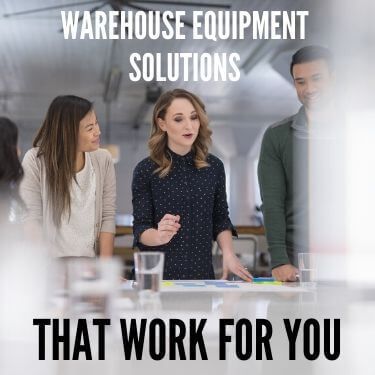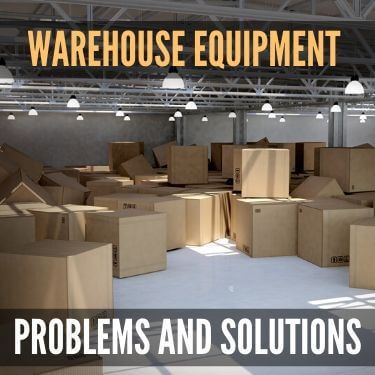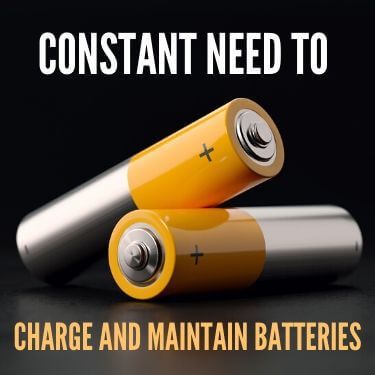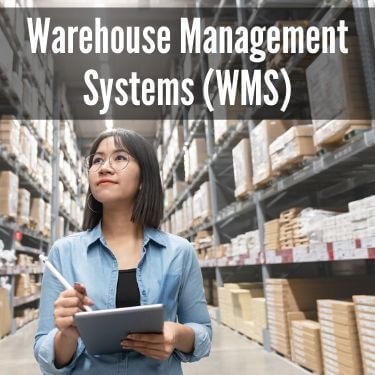
 Copy URL to Clipboard
Copy URL to Clipboard
There’s a difference between running a warehouse that meets standards and functions well and running a warehouse at maximum efficiency that exceeds goals. There are so many moving parts at one time, plus ongoing contingencies, that sometimes employees are just focused on getting the job done. That means problems with warehouse equipment and deciding on warehouse equipment solutions get pushed off until later and ineffective machinery doesn’t get the attention it should
Many challenges with warehouse equipment can be fixed by replacing the ineffective tool with the right kind of equipment, implementing new technology or streamlining an existing process. All three can take your warehouse operations from good enough to surpassing goals and generating more revenue. These innovative ideas will increase production and provide warehouse equipment solutions to common problems.
Table of Contents

The challenges of warehouse management can be extensive and it can be hard to take a step back and examine issues as they arise. With all the work that needs to be done, it’s tempting to just put the problem aside and focus on getting the immediate job done. Instead, get the full picture of what’s happening, and what should be happening, so the ongoing problem can be solved and the warehouse can function better in the future.
Sometimes the warehouse solutions are simple, like more manpower or an extra forklift, and you’re ready to move on to the next assignment. However, sometimes the problem is more challenging and requires a different thought process. The answer can come in the form of specialized equipment or technology, a new warehouse processing idea or an original storage solution.
You can go up high, but not high enough. Employees need more reach vertically when they’re picking orders.
Solution: Low-level needs are usually taken care of without issue by common order-picking equipment. However, sometimes that equipment isn’t able to reach higher positions where the needed items are located. In those situations, utilize a mid-level or high-level order picker. The user can then make their rounds around the warehouse while also easily having access to reach the upper-level racks.
If your warehouse is large, and most are, workers will have hands-on work that is at a high elevation. Most jobs that are high up require a platform that is stable and portable and that can access the hard-to-reach spaces where goods are stored.
Solution: have a variety of personnel lifts available in the facility. Lifts come in a wide range of styles that offer unique functionality and allow employees to get the job done in high places. Here are some options to add to your warehouse equipment list:
Narrow aisles are a common logistics problem. They can make it difficult to navigate in the warehouse and cause operations to slow. It can even lead to damage from forklift operators who bump into materials or storage equipment.
Solution: a narrow aisle forklift. They are specifically designed to use in tight spaces and some models are able to drive through a standard-sized doorway. If you have an extremely small space, go for the very narrow aisle forklift, which is capable of operating within the tightest of spaces.
Some models of narrow aisle forklifts are built for the operator to stand, not sit while using them. This enables to user to see the materials they’re picking or stocking better. Plus, you can equip most narrow aisle forklifts with various hydraulic attachments making them more versatile.
A warehouse that has narrow aisle forklifts can maximize the footprint of an existing warehouse or of a newly designed warehouse. This enables the users to add more warehouse racking to the configuration and store more goods within the same space.
Warehouse logistics require goods to be moved from Point A to Point B. In many cases, employees have to transport the material by carrying it themselves which takes away time from other important tasks.
Solution: consider getting an automated guiding vehicle (AGV) like a Weasel. The Weasel is an innovative product made by SSI Schaefer that works as a conveying system. It uses an easy-to-install optical tracking system and automated carts that navigate and transport goods from one point to another.

Electric forklifts and materials handling equipment are used throughout the day in a busy warehouse. Unfortunately, the batteries for such devices generally don’t last as long as you would like, causing the ongoing need for charging and maintaining them.
Solution: try the power source, game-changing development of using lithium-ion batteries. Although lithium-ion batteries are more expensive, you save money in annual maintenance costs. They charge much faster than lead-acid batteries, are safer and require little to no maintenance. This means no watering, acid, spills or fumes to worry about later. If you need an extra incentive, keep in mind that, unlike standard lead-acid batteries, they come with an extended warranty.
Lithium-ion batteries do not hold a charge for as long as a lead-acid battery, but it only takes a little over 90 minutes for them to fully recharge. Plus, if you use a lithium-ion battery in a pallet jack they can short the jack’s chassis length by several inches. This help’s the jack’s maneuverability as the worker navigates the warehouse.
Just like batteries, vehicles are used all day, every day. You may feel like charging and fueling vehicles can take too long and costs too much, especially when your fleet includes 50+ trucks.
Solution: Hydrogen. You can create your own fuel at your own facility if you power your fleet with hydrogen. Businesses produce hydrogen fuel, which is usually made from natural gas and water, by using a process called steam methane reforming. As it stands now, using hydrogen fuel is only cost-effective for larger companies. However, technology is advancing at a rate that mid-sized companies can soon benefit from this fuel source.
Using hydrogen fuel means instant refueling for your vehicles, eliminates downtime and the warehouse can repurpose the space and rooms that were originally used for battery charging and maintenance. Check out Nuvera, an innovating, Massachusetts-based hydrogen fuel cell company for more on this. Nuvera has become an industry leader in technology that charts the future of emissions-free hydrogen fuel.
It’s good when your operation is growing but not good when you don’t have enough trained forklift operators. Workloads continue to increase even though there are not enough skilled workers to keep up with the demand.
Solution: Look for materials handling equipment companies that also provide on-site, truck-specific training for the users who will be operating the equipment. You can kill two birds with one stone. The companies offer training and that training helps to stay compliant with OSHA regulations. Safety comes first, but your business will benefit in other ways as well. More forklift training also leads to increased productivity, lower insurance premiums and a reduction in equipment costs.
You have insufficient warehouse space as your business continues to grow and causes near full capacity. Soon enough you will need additional space for goods, equipment and employees.
Solution: You can help to maximize your current warehouse space by using new technology. One option is cutting-edge CAD technology, which utilizes 3D modeling to ascertain the optimal organization of your physical workspace and ongoing workflow.
You have other options if you’re trying to go a less high-tech route. Some physical improvements to your facility can help to squeeze more storage rack capacity out of your existing space. In other cases, you can try using mezzanine structures as a second or third level inside the warehouse.
You’ve been doing this for a while, and you know there must be a way to improve the warehouse workflow. Alas, you have little to no time to dedicate towards designing a more efficient system. There’s enough daily pressure to run a bustling warehouse without adding the extra task of analyzing warehouse operations.
Solution: This situation may call for the use of a consultant. A consultant who specializes in warehouse operations allows you to gain perspective from someone who is familiar with your industry and has ideas on how to make improvements. They can analyze your physical workspace, equipment, system and workflow to then recommend customized solutions that are tailored specifically to your unique situation and needs.
Plus, an outside consultant takes away the possibility of any biased viewpoints or relationships affecting the suggested changes. A good consultant will tell you what’s best for the warehouse and the current operations without being swayed towards one side or another. You can be confident knowing that their ideas are what’s best for the overall business.
One of the challenges faced by a warehouse manager comes when operations have been running well, no bumps or hiccups, but you think it could be better. There may be opportunities to increase efficiency using automation, but you’re not sure what those opportunities are and how to go about finding them.
Solution: Take a look at Baylo. They are a Paris-based company that has been partnering with Hyster-Yale to create self-guided, cutting-edge robotic vehicles. Their system first uses a laser to map out your facility and then advanced software enables self-guided trucks to go to work. The trucks work alongside employees to perform a full spectrum of materials-handling functions.
Baylo’s devices can be programmed on several levels. The vehicles can be told when and where to pick up an item, move it to the given location and configure the best positional placement for the item by analyzing the rack.
If you’re a fan of new automated tools and vehicles, read on to learn more about the latest and greatest gadgets to use in your warehouse.

Technology is ever-evolving and at a rate that makes it hard to predict what’s next. This is particularly true when it comes to warehousing, distribution and logistics. Combining technology and logistics has led to the term “smart warehouse,” which has become a reality by ready-to-purchase technologies that are changing the way warehouses operate.
It can be hard to keep up and navigate the emerging world of smart warehousing considering the rate at which products are introduced to the field. Here are the most popular and techy products and processes that have been added to smart warehouse industry. Some may be more familiar than others, but all can bring value to your operations and assist in warehouse equipment solutions.
Say goodbye to error-riddled picking when you say hello to picking automation elements. Your warehouse can experience near-perfect picking rates when you add automated picking elements to the process. There are a multitude of different tools that can be utilized to boost picking procedures. Some of your options include:
Cutting-edge barcoding options are used with these tools and can integrate seamlessly with your chosen management software. This results in faster, more accurate automated reporting and fast + accurate = more productive workflow.
Automatic guided vehicles, or AGVs, are one of the best ways to improve your storage and retrieval process. Their structural integrity technology is still evolving but what is currently on the market has proven to be safer and have a higher ROI than manual labor.
Like the Weasel mentioned above, AGVs can replace some of the more basic and manual tasks that employees are charged with, and thereby allow those employees to work on higher-level and more important jobs. Essential functions AGVs can handle include pallet, rack, other container storage, as well as helping to control and automate receiving procedures.
These platforms are integrated to take the labor, guesswork and superfluous time out of conventional inventory control. They are utilized best when they are used in concurrence with several other technological mainstays, such as asset and inventory tags.
Additionally, most automated inventory control platforms are built to automatically count inventory and analyze the data. This means the platform’s reporting is fast, in real-time and extremely accurate, all of which can be accessed remotely.
Automated storage and retrieval systems are not new and historically they have worked to improve throughput and accuracy. However, they have usually been considered too expensive, clunky and inflexible for practical use. If they were introduced to the warehouse, users could expect to have reduced labor costs or restrictions, modular options and increased accuracy.
Fortunately, with improving technology comes AS/RS’s that are getting sleeker while maintaining their original benefits. Keep this in mind next time you look into automated tools for your warehouse. One of the benefits from advanced tech includes more than new gadgets, but also improvements and updates to older devices.

A warehouse management system, or WMS, is a comprehensive software system that consolidates all your important warehouse and logistical data into one platform. This data is easily accessible by internal employees and select workers from your supply chain.
Compartmentalizing the data creates lightning-fast reporting when can then lead to exceedingly efficient planning. WMS solutions can be highly instrumental in situations that were unforeseen by giving data, and showing the issue before it turns sour. Implementing a warehouse management system with other automated elements is an ideal pairing that can only lead to increased productivity and increased profits.
You don’t need to make extreme changes to your current warehouse operations to make it more productive and efficient. Sometimes, all it takes is the right technology for your business to see vast improvements in the current workflow. You don’t need every automated tool to become a smart warehouse, just the right device necessary to impact your operations.
R+L Global Logistics offers a wide variety of warehousing service solutions and fulfillment needs. We know what is required to run warehouse operations successfully and efficiently. Our fulfillment and distribution services include:
We handle everything and anything needed for warehousing services. Our team of professionals is ready to assist you in your fulfillment and distribution needs. Chat, email, or call us at 866-989-3082 to talk to an agent for more information about your warehousing and fulfillment options when using R+L Global Logistics.
